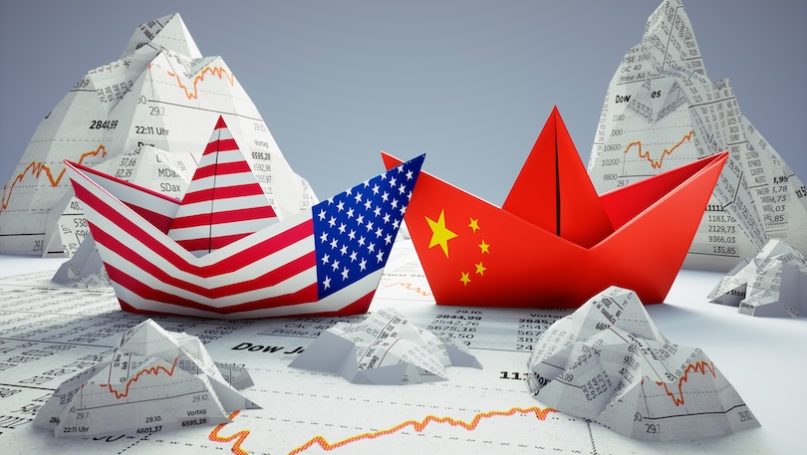
This case study is an excerpt from McGlinchey, Stephen. 2022. Foundations of International Relations (London: Bloomsbury).
The strategies leading up to a trade war follow the principle of tit for tat or ‘equivalent retaliation’ where one actor copies an opponent’s previous action to inflict economic costs. This behaviour can lead to economic conflict in which states use extreme forms of protectionism such as high tariffs or quota restrictions to directly damage each other’s trade. During the presidency of Donald Trump (2017–2021), his administration took a mercantilist position in an increasing number of trade disputes with China. That approach asserts that given limitations on global wealth, a state must export more than it imports to secure an advantage over rivals. In the past, World Trade Organization rules have been respected by state actors eager to prevent mutually damaging trade wars. The Trump administration, however, escalated a trade conflict to address recurring annual trade deficits that the US had amassed. It challenged the industrial policies implemented by Chinese authorities, such as the ‘Made in China 2025’ policy, which allegedly resulted in unfair competitive advantages on global markets (Qiu et al. 2019).
For some time, US–China trade did not match the expectation of win-win cooperation. In contrast to the idea of comparative advantage – state-directed investments, a non-market economy, and widespread disregard for the rule of law in China created an atmosphere of suspicion. From the American perspective, Chinese companies gain an unfair advantage over foreign competitors seeking market access. In their own market they engage in intellectual property theft, product piracy, and the forced transfer of foreign technology. Consequently, the dispute between the two powers, which has continued in the post-Trump years, is not about trade as such – but about technology induced job losses in the United States aggravated by a manipulated exchange rate policy. Moreover, there is a growing concern that China uses its FDI to access sensitive technology to outgrow US industrial capabilities. In line with realist thought, the acquired know-how from sensitive production lines could eventually create a security dilemma. The use of unfair trade practices including import restrictions such as tariffs and quotas, export subsidies and low interest loans as well as stringent local content requirements adds up to an image of a new economic superpower that needs to be contained (Liu and Woo 2018, 333).
Frequently, foreign firms find their access to Chinese markets conditional upon joint ventures with domestic, government-linked companies even if the latter develop into competitors on global markets. The Trump administration chose to confront such practices bilaterally rather than through the World Trade Organization complaints procedures related to market access. Hence, relative gains considerations matter in terms of competitiveness as well as national security. The trade war escalating on multiple fronts reflected the hesitation of the US to promote further economic globalisation to the detriment of its own hegemonic position in the system. The Belt and Road initiative adds to these worries as China combines economic power with geopolitical interests and aspires to become the biggest aid donor in Africa and Asia.
For realists, a trade war is not an indicator of a failed foreign economic policy or of unreasonable demands from another state. Even if two states set out with a commitment to free trade, each partner still has an incentive to defect to a higher tariff. Under the assumption that the other party will not reciprocate, the dominant state always benefits from unilateral action at the expense of its counterpart. For example, by increasing the costs for specific imports to help its domestic producers. At the same time, being aware of the incentives (and domestic pressures) to deviate from free trade, retaliation is likely and mutual losses are anticipated. A case in point is American farm exports which were targeted by China with a 25% tariff rise. Within one year, the value of US sales fell by one third and the federal government resorted to publicly funded subsidies to bail out American farmers.
During the course of the trade war, both sides suffered significant losses in their bilateral export volumes with higher prices hurting consumers. Equally, private and state-owned companies experienced increasing production costs that reduced their competitiveness on global markets and triggered job losses due to falling sales. Xi Jinping and Trump finally agreed to partially suspend their trade war efforts, eventually leading to the signing of a new agreement in January 2020. The so-called ‘phase one’ deal committed China to buy American manufactured goods, services, energy and agricultural produce worth an extra $200 billion dollars over a two-year period. While ignoring World Trade Organization governance, the United States negotiated an outcome-based trade deal with verifiable trade flows and immediate market access. Yet, the voluntarily agreed import expansion by China failed to materialise and many retaliatory tariff measures remained in place or changed only slowly. The focus on export targets only briefly overshadowed other problems such as non-tariff trade barriers, FDI, and the protection of intellectual property which will likely remain on the agenda for years to come.
International Political Economy accounts with sensitivity to domestic politics point to the politicisation of trade relations, qualifying the ‘phase one’ deal as a fundamentally wrong approach to deal with the causes of the bilateral trade deficit between the US and China. Indeed, assuming hegemonic rivalry, the tense US–China relations after the trade war generate further disputes over key economic policy issues, at least until the political leadership of both states can agree on a reform of the multilateral trade regime. For the United States this implies reviving collaborative efforts with the European Union and Japan to strengthen general World Trade Organization mechanisms especially as regards industrial subsidies, investments and market access. For China, an improving compliance record within a reformed trading system will only become viable in return for a formal recognition of its socialist market economy where state owned enterprises and the Communist party continue to dominate.